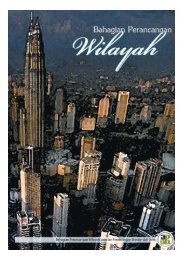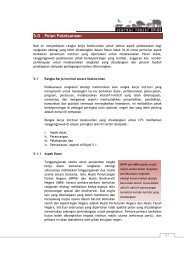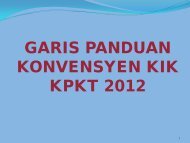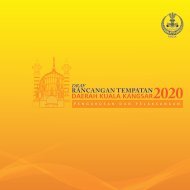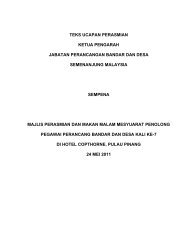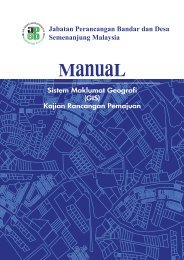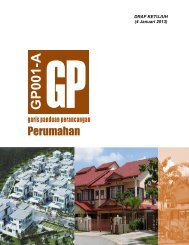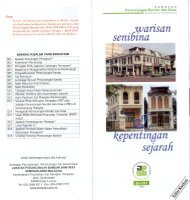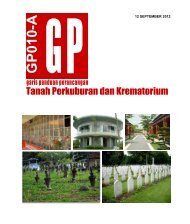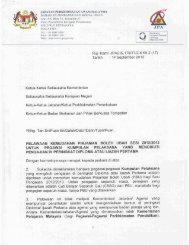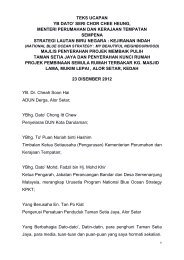Low Carbon City Framework
Low Carbon City Framework
Low Carbon City Framework
You also want an ePaper? Increase the reach of your titles
YUMPU automatically turns print PDFs into web optimized ePapers that Google loves.
Townships and Urban DevelopmentCities/Urban Areas Emit GHGSources of Green House GasIndustrial Agriculture Forestation19% 14% 17%Other UrbanDevelopment50%Commercial & Residential – 8%Transport – 13%Waste – 3%Electricity production“CO2 is the most important anthropogenic of GHG and the main sources of atmospheric CO2 isfrom burning of fossil fuels – 75% of increase in atmospheric CO2 since industrial times (Source:Cities and Climate Change – Global Report on Human Settlements 2011, UN-Habitat).Malaysian Institute of Planners3
Townships and Urban DevelopmentMalaysian Institute of Planners4
Townships and Urban Development"CO2 emissions for transport sector has increased from 35 billion kg in 2000 to 119 billion kg in2010, while for housing sector is from 3.9 billion kg to 4.7 billion kg in 2010“ (Source: Asia-Pacific IntegratedModel, AIM)Malaysian Institute of Planners5
Malaysia Roadmap- Local Actions Towards Green and SustainabilityUnited NationsConferenceon the HumanEnvironmentUnited Nationsset up the WorldCommission onEnvironment andDevelopmentBruntland Reporton definition andprinciples ofsustainabledevelopmentRio Summit:Worldcommitment onsustainabledevelopment &Agenda 21KyotoDeclarationon GreenHouseEmissionJohannesburgEarth Summit2002, Rio +10Bali RoadmapTowardsInternationalagreement onCOP 15Climate ChangeCopenhagenAccord1972 1980 1987 1992 1997 2000 2002MalaysiaNationalEnvironmentalPolicyMalaysia (LocalAgenda 21)Planning Doctrine– holistic dev. forland use planning2000 – 5 th FuelPolicy, in the 8 thMalaysia PlanSREP (smallrenewal energypower program)2004 – Ministry of Natural Resources andEnvironment2005 – National Physical Plan SelangorSustainable Development and Agenda 212006 - Malaysia Ninth Malaysia Plan – 4 thThrust (Improve Standard and Sustainabilityof Quality of Life)- Sustainable DevelopmentIndicators (SDI); RE – From Waste to Energy2006 – National Urbanisation PolicyApril 2009 – Ministry of Energy, Technologyand WaterMalaysian Institute of PlannersJuly 2009 – National Green TechnologyPolicy6
Malaysia: Policies and PlansCurrently, there are many plans & policies related to sustainable and greendevelopment in Malaysia.KeyNationalDirectionsNationalLegislationsNational &DevelopmentPlansNationalPoliciesEconomicRegionsMaster PlanNew EconomicModel (NEM)Tenth MalaysiaPlan (RMK 10)EconomicTransformationProgram (ETP)RegulationActsNationalPhysical Plan(NPP)NationalUrbanizationPlan (NUP)State StructurePlansNational Policyon theEnvironment(2002)National GreenTechnologyPolicy (2009)National ClimateChangePolicy (2009)SabahDevelopmentCorridor (SDC)SarawakCorridor OfRenewableEnergy (SCORE)ComprehensiveDevelopmentPlan (CDP)East CoastEconomic Region(ECER)Malaysian Institute of Planners7
<strong>Low</strong> <strong>Carbon</strong> Cities <strong>Framework</strong> & Assessment System- Purpose of the Guiding DocumentObjective of<strong>Low</strong> <strong>Carbon</strong>Cities<strong>Framework</strong>(LCCF) &Assessmentsystem• To encourage & promote theconcept of low carbon citiesand townships in Malaysia.• To increase the compatibility ofcities/townships with theirlocal natural system.• To guide cities in makingchoice/decisions towardsgreener solutions.“It is my dream that one day wecan live in a clean, healthy andhigh quality environment, wherecities, townships and communitiesare built on the fundamentals ofGreen Technology”YAB Dato’ Sri Mohd Najib TunRazakUsersTargets• All Cities & Townships inMalaysia• To promote water and energyefficient by saving 10% andreduce GHG by 40% per GDPper capita by the year of 202010 %Malaysian Institute of Planners8
Malaysia Commitment40 % reduction of carbon intensityper GDP per capita by 2020Emission Reduction Target (ERT)• To achieve 40 % below 2005 GHG emission levelsby 2020 (based on <strong>Carbon</strong> Intensity i.e. tCO2e/GDP)Malaysian Institute of Planners9
The National ContextPOLICIES ANDCOMMITMENTS FORCO2 REDUCTION OF40%POLICY :GOVERNMENT MALAYSIA- KeTTHA / KKR / NRE /Other MinistriesLOW CARBONCITIESFRAMEWORK &ASSESSMENTSYSTEMSTRATEGIESKEY TARGETS BY SECTORSPERFORMANCEINDICATORSNATIONAL ASSESSMENTTOOLS & GUIDELINESCITIES & TOWNSHIP :GREEN TECH MALAYSIA /FEDERAL DEPT TOWN &COUNTRY PLANNING DEPT/LOCAL GOVT /DEVELOPERS/KEY STAKEHOLDERSRATING TOOLS BY RELATED INDUSTRIESGREEN BUILDING INDEXBREEAM (UK)LEEDS (US & CANADA)GREENMARK (SINGAPORE)GREENSTAR (AUSTRALIA)BUILDINGS :GOVERNMENT AGENCIES &INDUSTRY PLAYERSMalaysian Institute of Planners10
LCCF & Assessment System- Use of DocumentThis document is to assistlocal authorities,township developers,designers and individualsin assessing whetherdevelopments carried outwithin the citycontributes towards thereduction or decrease inGHGMalaysian Institute of Planners11
National Assessment ToolsSustainable <strong>Framework</strong> for <strong>Low</strong> <strong>Carbon</strong> <strong>City</strong>National PolicyLOW CARBON CITYSUSTAINABLE FRAMEWORKASPECTSLIVABILITY INDEXCommunity WellBeingServicesEconomyTransport &MobilityNatural & Built EnvironmentEquality & DiversityGovernanceGREENNEIGHBOURHOODGUIDELINESGHG INDEXMISSION (40% GHG REDUCTION)TARGETKEY ELEMENTSGAP/STATUSUrban EnvironmentUrbanTransportationUrbanInfrastructureBuildingPERFORMANCE BASEDSTANDARDROADMAPASSESSMENT SYSTEMRating ToolsGREEN RATING TOOLSMalaysian Institute of Planners12
National Assessment ToolsLCCF & Assessment SystemGHGINDEXMISSION (40% GHGREDUCTION)TARGETKEY ELEMENTSGAP/STATUSUrbanTransportationUrbanEnvironmentUrbanInfrastructureBuildingPERFORMANCE BASEDSTANDARDROADMAPASSESSMENT SYSTEMRating ToolsGREEN RATING TOOLSMalaysian Institute of Planners13
LCCF & Assessment System– Key FeaturesFour (4) Main Components in the framework of GHG analysisKey Elements toMeasureBaselinesNeededTargets & GapsRoadmap1: Identify Elements toMeasure• Understand whichelements contributemost to the city’s GHGemission• Prioritize/choose whichelements to measure(all?/specific elements?)2: Territory Boundariesor Area of Concern:• AdministrativeBoundaries of The<strong>City</strong>/Any area of a city.• Single Source SolutionsCurrent Status ofGHG emission• Baseline informationon current GHGemission level.• BAU Levels –projected emission• If non available ofbaseline data –benchmarks againstother baselines canbe used as a guide.Source of generation• Identify the keysource of generation.Targets• Set targets forreduction of GHGemission• Targets should beachievable andmeasurableGaps• Identify the gapsbetween currentemission status andtargets.• Identify measuresRoadmaps• Set a RoadmapMalaysian Institute of Planners14
Contents of ReportPART ONE – LCC <strong>Framework</strong>PART TWO – Assessment System1234Introduction1. Green house Gases (GHG) – Concept & BriefOverview2. Background of <strong>Low</strong> <strong>Carbon</strong> Cities <strong>Framework</strong>3. A Case for Change4. Malaysia & TrendSustainable <strong>Framework</strong> For <strong>Low</strong> <strong>Carbon</strong>Cities1. Definition of <strong>Low</strong> <strong>Carbon</strong> <strong>City</strong>2. Sustainable <strong>Framework</strong> for <strong>Low</strong> <strong>Carbon</strong> CitiesKey Features of LCCF1. Performance Based System2. Elements That Contribute to GHG Emissions3. Approach4. Application of LCCF5. Relationship Between <strong>Framework</strong> and CalculatorPerformance Criteria For <strong>Low</strong> <strong>Carbon</strong>Cities567The <strong>Low</strong> <strong>Carbon</strong> Cities Assessment System(LCCAS) Calculator – Concepts And Principles1. About the LCCAS Calculator2. Who will use it?3. The Relevance of the Assessment System andCalculator4. The Concepts and Principles5. <strong>Carbon</strong> NeutralityRelevant <strong>Carbon</strong> Factors1. Urban Environment2. Urban Transportation3. Urban Infrastructure4. BuildingUser Guide1. Using the LCCAS Calculator2. Summary Sheet1. Introduction of Parameters for GHG Reductions2. Relationship To <strong>Carbon</strong> Parameters3. Elements of Lifecycle AssessmentMalaysian Institute of Planners15
Performance Criteria for GHG Reductionsfor Cities4 ElementsContribute toGHG emission14PerformanceCriteria38Sub Criteria• Urban Environment• Urban Transportation• Urban Infrastructure• Building• Urban Environment (3)• Urban Transportation (4)• Urban Infrastructure (4)• Building (2)• Innovation (1)• Urban Environment (14)• Urban Transportation (7)• Urban Infrastructure (9)• Building (7)• Innovation (1)Save Green Save FuturePerformance Criteria are measurable strategies to reduce carbonemission through:-- Policy control, Technological development, better process & productmanagement, change in procurement system, carbon capture,consumption strategies & others.Malaysian Institute of Planners16
Performance Criteria for Urban EnvironmentUE 1 : Site Selection1-1: Development within defined urban footprint1-2: Infill development within existing urban footprint1-3: Development within transit nodes and corridor1-4: Brownfield and Grey field redevelopment1-5: Hilly slope developmentUE 2 : Urban Form2-1: Mixed-use development2-2: Compact development2-3: Road and parking2-4: Comprehensive pedestrian network2-5: Comprehensive cycling network2-6: Urban Heat Island (UHI) effectsUE 3 : Urban Greenery And Environmental Quality3-1: Preserve natural ecology, water body and bio-diversity3-2: Green open space3-3: Number of trees3PERFORMANCECRITERIA14 SUB CRITERIAELEMENT 1:URBANENVIRONMENTUE 1 : SITE SELECTIONUE 2 : URBAN FORMUE 3 : URBAN GREENERY& ENV. QUALITYMalaysian Institute of Planners17
Performance Criteria for Urban TransportationUT 1 : Shift of Transport Mode1-1: Single Occupancy Vehicle (SOV) dependencyUT 2 : Green Transport Infrastructure2-1: Public transportation2-2: Walking and cyclingUT 3 : Clean Vehicles3-1: <strong>Low</strong> carbon public transportation3-2: <strong>Low</strong> carbon private transportationUT 4 : Traffic Management4-1: Vehicle speed management4-2: Traffic Congestion and traffic flowsmanagement4PERFORMANCE CRITERIAELEMENT 2:URBANTRANSPORTATIONUT 1 : SHIFT OFTRANSPORT MODEUT 2 : GREENTRANSPORTINFRASTRUCTUREUT 3 : CLEAN VEHICLESUT 4 : TRAFFICMANAGEMENT7 SUBCRITERIAMalaysian Institute of Planners18
Performance Criteria for Urban InfrastructureUI 1 : Infrastructure Provision1-1: Land take for infrastructure and utility services1-2: Earthworks management1-3: Urban storm water management and floodmitigationUI 2 : Waste2-1: Construction and industrial waste management2-2: Household solid waste managementUI 3 : Energy3-1: Energy consumption3-2: Alternative Energy sources3-3: Site wide district cooling systemUI 4 : Water Management4-1: Efficient Water Management4PERFORMANCECRITERIAELEMENT 3:URBANINFRASTRUCTUREUI 1 : INFRASTRUCTUREPROVISIONUI 2 : WASTEUI 3 : ENERGYUI 4 : WATERMANAGEMENT9 SUBCRITERIAMalaysian Institute of Planners19
Performance Criteria for BuildingsB1 : <strong>Low</strong> <strong>Carbon</strong> Buildings1-1: Number of low carbon footprint buildings1-2: Building energy operational emissions1-3: Building water operational consumption1-4: Building performance1-5: Building orientation1-6: Chill water system from district cooling plantB2 : Community Services2-1: Shared facilities and utilities withinbuilding2PERFORMANCECRITERIAELEMENT 4:BUILDINGB 1 : LOW CARBONBUILDINGSB 2 : COMMUNITYSERVICES7 SUB CRITERIAMalaysian Institute of Planners20
A One System ApproachA <strong>City</strong> Based ApproachAssessment Approach to EncourageImplementationUser can opt to undertake a One-System Approach or a <strong>City</strong>-basedApproach depending on theirobjective and capacity.A OneSystemApproachA <strong>City</strong>BasedApproach• Enables users torealize benefitsof integration byplanning,designing andmanaging thewhole urbansystem• E.G.: Yokohamawaste reductionprogramme(estimated totalwaste reductionfor fiscal years2001-2007 is623,000 tonswhich leads toreduction of840,000 tons ofCO2• Enables users tolead adevelopmentprocess thatconsider theirspecificcircumstancesincluding ecology• E.G.: Stockholm(an old inner cityindustrial areatransform into anattractive andecologicallysustainabledistrict throughan integrated andcollaborativeplanning andmanagement)Malaysian Institute of Planners
Criteria To Start <strong>Low</strong> <strong>Carbon</strong> Cities Project– Road Map/Action Plan1• Identify areas of concern2• Identify priorities – (low hanging fruits and easy to implement)3• Cost efficient4• Benefits a wider range of communities5• Can be measured, reported and verified (MRV)67• Inline with the Green Technology Policy• Supporting the government efford towards achiving the 40% CO2reduction/GDP/capita by 2020.22
LCCF & Assessment System- Flow and RelationshipPART 1 – LCC FRAMEWORK4 ElementsPerformanceCriteria<strong>Carbon</strong>CalculatorAnd UserGuidePerformanceCriteriaMeasurementCARBONREDUCTIONPART 2 – LCC CALCULATORAssessment Using<strong>Carbon</strong> Calculator14 PerformanceCriteria and 38Sub CriteriaPerformance Based Assessmentin the form of Total <strong>Carbon</strong>Reduction5 Elements• Urban Environment• Urban Transportation• Urban Infrastructure• Building• InnovationMalaysian Institute of PlannersCARBON REDUCTION
APPLICATION OF LCCF & LCCAS
Process & Procedure Application of LCCF &Assessment System– Towards <strong>Low</strong> <strong>Carbon</strong> <strong>City</strong>IdentifyprojectROAD MAPEstablishApproachtowardsmeasuringGHG emissionfor LCCEstablishBAU <strong>Carbon</strong>EmissionandReductionLevelDefine<strong>Carbon</strong>ReductionStrategiesEstablish<strong>Low</strong>er<strong>Carbon</strong>FootprintTargetLOWCARBONCITYPlan FurtherReductionMeasurePerformancePeriodicallyImplement <strong>Carbon</strong> ReductionMeasuresBAU –Business As UsualMalaysian Institute of Planners
Malaysian Institute of PlannersLCCAS is a Performance Based Assessment• The environmental achievements in adevelopment are defined by thesum of the CO2 reduction overthe baseline CO2 emissions.• Projects/developments shall beawarded with the correspondingenvironmental performanceachievements according to theachievement level.LCC ACHIEVEMENT LEVEL<strong>Carbon</strong>ReductionLevelLevel of Achievement100% <strong>Carbon</strong> Neutral70-95%50-69%Best Practice 1 (BP1)Best Practice (BP2)• The maximum limit of 40% Co2reduction aligns with the commitmentmade by Malaysia in arriving at the2020 target.30-49%10-29%1%-9%Best Practice 3 (BP3)Best Practice 4 (BP4)Best Practice 5 (BP5)
Sample CalculatorReduced <strong>Carbon</strong>Footprintie Projectedemission (B)Reduction inCO2 (A-B=C)% reduction CO2/totalCO2 (C/A x 100 = D)Baselineemission (A)Summary table UT 1-1. Appear onevery calculator sheet. Linked tothe summary of overall calculatorData to be filled in.Parameters:1. No ofhouseholds2. No of shop lots3. No of offices4. No of industriesLegendInput data in yellow cellsDevelopment details and CalculationsBaselineemissionBenchmarks details and calculations Malaysian Institute of PlannersReduced<strong>Carbon</strong>FootprintieProjectedemission
UrbanEnvironmentUrbanTransportationUrbanInfrastructureBuildingSummary Sheet- Achievement Level Based on Application of Weightage SystemElement Criteria Sub CriteriaUE 1: UrbanFootprintUT 1: Shift ofTransport ModeUT 2: GreenTransportInfrastructureUI 1: InfrastructureProvisionB 1: <strong>Low</strong> <strong>Carbon</strong>BuildingsUE 1-1UE 1-2UT 1-1UT 2-1UI 1-1UI 1-2B 1-1Prioritize developmentwithin defined urbanfootprintEncourage sustainabledevelopmentintensitiesReduce SingleOccupancy Vehicle(SOV) travelingIncrease utilization ofpublic transportationReduction of land areafor infrastructure andutility servicesImplement site widedistrict cooling systemIncrease number ofbuildings with lowcarbon footprintSUMMARY SHEETSummary – Total <strong>Carbon</strong>Emissions (tCO2/yr)% reductionachievedWeightage%reductionA B C D 10 XAbsolute CO2reduction10 Y10 Z10 XX5 yy5 zzTOTAL tCO2e 15 %10XYMalaysian Institute of PlannersBP 4
Malaysian Institute of PlannersTHANK YOUMalaysian Institute of Plannersin association withDr Faridah ShafiiBK Sinha




